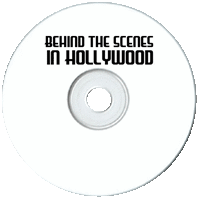

Bidwell McCormick worked in the publicity department at RKO and produced this show to share the magic of the movies. This old time radio show gives listeners an up close and personal look at the action behind the cameras in the golden age of Hollywood.

18 old time radio show recordings
(total playtime 3 hours, 48 min)
available in the following formats:
1 MP3 CD
or
4 Audio CDs
Text on OTRCAT.com ©2001-2025 OTRCAT INC All Rights Reserved. Reproduction is prohibited.

RKO Pictures produced a 15 minute radio show in 1945 that provided listeners and fans with a look behind the curtain at the inner workings of a studio. The show was hosted by RKO publicist Bidwell McCormick.
There were star profiles, information about the books they wrote, hobbies, movies they were starring in and upcoming movies. For instance, did you know Edward G. Robinson did not like guns and had to work hard to keep his eyes open whenever he fired a gun in a movie.

The hosts also provided a lot of the same time of information you find today like which books were optioned for movies, movie release dates, and so much more. If you are an old movie fan, this series provides fascinating background so don't miss it!
Movies are all about make-believe. That is something that even the most unsophisticated viewer understands, accepts and promptly forgets. It is part of what makes movies so magical. Movie magic is a lot more fun than stage magic. If the audience knows how the trick is done, the stage magician's show is ruined but the "magicians" who worked in Hollywood's big studios were more than happy to share how their tricks are done.
Knowing how movies are made seems to make audiences even more excited to see the final result and to a studio boss, anything that gets more people to the box office is a good thing. This leads to the belief that any publicity is good publicity, and studio publicity departments know that if people are talking about a movie, eventually they are going to buy a ticket and see the movie.
Bidwell McCormick worked in the publicity department at RKO and kept an ear out for what was happening in and around the movie industry. It becomes apparent that the movie business was more than just a way for McCormick to put supper on the table, he became entranced with the entire filmmaking industry. To share this passion, he put together a weekly quarter-hour radio program called Behind the Scenes in Hollywood. Whether his employer, RKO Studios, had anything to do with the program is difficult to say. The fact that McCormick handled the program's syndication himself seems to indicate that the studio was not involved, but the most telling detail is the amateurish performances and production values of the programs. Actors, films, and techniques from all the major studios are discussed on the program.
Listening to McCormick hosting the show it seems obvious that he has little background in public speaking or acting, however, the content of the program displays an encyclopedic knowledge of movies, production techniques, Movie Stars, and Hollywood gossip. The other voices on the program, Nathan Hale and Manna Ray Eule, seem to have a more professional radio presence. Hale particularly may have been a pseudonym used by an actor working at Allied Recording, the studio where the syndicated program was recorded.
Although the on-air performances may not be first-rate, the material covered is truly unique and interesting. Personalities Hedy Lamarr, Ronald Colman, midget Billy Barty, Danny Kaye, Pat O'Brien, Larraine Day, Claire Trevor, Janice Paige, and Dick Powell are all profiled in different episodes. Technical discussions range from costuming choices to scenery painting for black and white films to Disney's techniques for combining live actors and animated characters in The Three Caballeros (1944).
The recording dates listed for Behind the Scenes in Hollywood are all January 1944, but it seems likely that the recording sessions were spread out over a series of weeks or months. The recordings were discovered amongst the estate of Bidwell McCormick and represent an inside look at the movie industry during Hollywood's Golden Age.
See also the simliarly titled radio program: Behind the Scenes.
Text on OTRCAT.com ©2001-2025 OTRCAT INC All Rights Reserved. Reproduction is prohibited.
You have reached the maximum number of votes for a unregistered user.
Please login or create a new account to continue...
You have reached the maximum number to down votes in this page.



Behind the Scenes in Hollywood Disc A001
|
Add Audio CD to Cart - $5.00 |
Behind the Scenes in Hollywood Disc A002
|
Add Audio CD to Cart - $5.00 |
Behind the Scenes in Hollywood Disc A003
|
Add Audio CD to Cart - $5.00 |
Behind the Scenes in Hollywood Disc A004
|
Add Audio CD to Cart - $5.00 |
Please wait...
COMMENTS
Be the first to comment on "Behind the Scenes in Hollywood"
Leave a comment